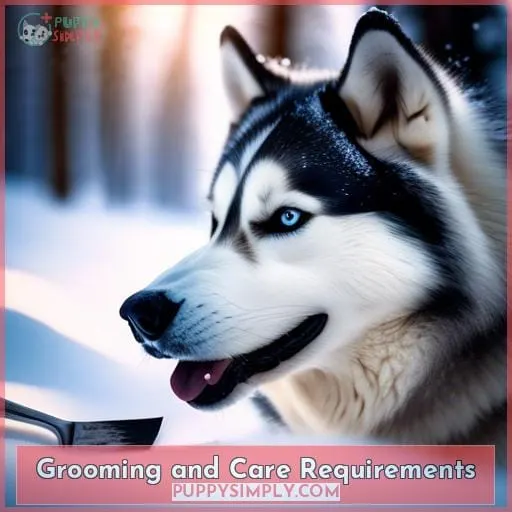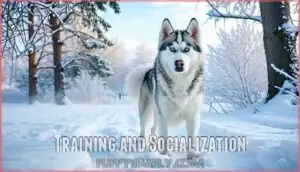This site is supported by our readers. We may earn a commission, at no cost to you, if you purchase through links.

Huskies are beautiful dogs, but they also come with their own set of unique challenges.
In this article, we’ll cover everything you need to know about husky life expectancy, costs, temperament, and care.
This will help you make an informed decision about whether or not a husky is the right dog for you.
Table Of Contents
Key Takeaways
Huskies have a life expectancy of 12-14 years, with common health issues including hip dysplasia, cataracts, and skin conditions.
The initial cost of adopting a Husky ranges from $275 to $1,400, with ongoing expenses such as pet insurance ($31-$46 monthly), food ($50-$100 monthly), and grooming needs.
Huskies are known for their friendly and playful temperament, requiring plenty of exercise and mental stimulation to thrive. They are affectionate companions and loyal protectors, making them suitable for active families.
Grooming a Husky involves managing their thick double coat with special brushes and deshedding tools. They also need at least 2 hours of vigorous activity daily and benefit from training sessions or puzzle toys for mental stimulation.
Husky Life Expectancy and Health
Let’s chat about the life expectancy of your husky.
Common health problems they face include hip dysplasia, cataracts, and skin conditions.
Factors that can affect how long your furry friend will be by your side include genetics, diet, exercise, and overall healthcare.
Common Health Problems
Common health problems in Huskies include:
- Cruciate ligament injuries, a common orthopedic issue.
- Dental illness, such as periodontal disease and tooth decay.
- Congenital conditions, such as hip dysplasia and elbow dysplasia.
- Hereditary conditions, such as cancer and eye diseases.
Regular physical consultations, including dental checkups, are crucial for early detection and treatment of these conditions, helping your Husky live a long and healthy life.
Factors Affecting Life Expectancy
Your husky’s life expectancy hinges on a delicate balance of genetics, diet, exercise, and the loving environment you provide.
Just like us, huskies thrive with a healthy diet and regular exercise.
Regular vet checkups and prompt treatment of any health issues can also add years to their happy, playful lives.
The Cost of Husky Ownership
Owning a husky comes with its expenses, from the initial purchase or adoption fees to the ongoing care and maintenance costs.
Be prepared to invest in your husky’s health, well-being, and happiness.
Initial Purchase and Adoption Fees
When considering bringing a Siberian Husky into your life, it’s essential to understand the financial commitment involved.
- Adoption Costs: If you’re adopting, fees can range from $275 to $400, with puppies typically costing more.
- Pet Insurance: Monthly premiums for insuring your Husky can vary, but most owners spend between $31 to $46.
- Home Modifications: To accommodate your new furry friend, you might need to make some changes to your home, like securing a yard or creating a dog-friendly space.
Ongoing Care Expenses
Ongoing care for your Husky can set you back a pretty penny. Food, supplies, vaccinations, and dental checkups will be recurring expenses. You’ll also need to factor in grooming costs to keep that thick coat in tip-top shape.
But don’t forget the importance of mental and physical stimulation to keep your Husky happy and healthy.
| Expense | Frequency | Cost |
|---|---|---|
| Food | Monthly | $50-$100 |
| Supplies (toys, treats, etc.) | As needed | $20-$50 |
| Vaccinations | Annually | $50-$100 |
| Dental checkups | Annually | $100-$200 |
| Grooming | Monthly | $50-$100 |
Understanding Husky Temperament
Huskies are known for their friendly and playful nature, which makes them a joy to have around.
They’re intelligent dogs that require plenty of exercise and mental stimulation to stay happy and healthy.
Friendly and Playful Nature
Huskies are affectionate companions and loyal protectors who bring joy to their families.
But don’t be fooled by their mischievous prankster side – they’re also incredibly loyal and protective of their loved ones. Their friendly and playful nature makes them a great choice for families with children and other pets.
Exercise and Mental Stimulation Needs
Continuing from the joyous nature of Huskies, let’s dive into their need for exercise and mental stimulation. Your Husky’s playful spirit requires an outlet, and without it, you might find your furry friend turning into a mischievous escape artist.
Aim for at least 2 hours of exercise duration daily to keep those paws busy and that mind sharp.
Mental stimulation activities are just as crucial as physical exercise. They prevent potential behavior issues that stem from boredom. Think of it as a daily brain workout—puzzle toys, obedience training, and even a game of hide-and-seek with treats can do wonders for your Husky’s mental health.
Puppy socialization is another key aspect. Introducing your Husky to a variety of experiences early on can help them grow into well-rounded adults. This can prevent behavioral conditions later in life, such as aggression or fearfulness.
Lastly, consider husky insurance to cover any congenital conditions and ensure you can provide the best care for your Husky throughout their life.
Grooming and Care Requirements
Managing your Husky’s thick double coat requires consistent grooming to minimize shedding and maintain their skin and coat health.
Regular exercise is just as important, ensuring your energetic Husky stays fit and mentally stimulated.
Managing Shedding
Managing the shedding of your Siberian Husky requires a bit of elbow grease and the right tools. Special brushes and deshedding tools are your best friends in this grooming routine.
A dog rake or a FURminator can work wonders on that dense, double-coated fur, reaching down to the undercoat to remove loose hair effectively.
While vacuum frequency in your home might increase, it’s a small price for the joy your fluffy companion brings. Remember, these sled dogs, hailing from the Chukchi people, are built for the cold, so managing shedding is part of the huskies as pets costs life expectancy and temperament package.
Keep up with the grooming, and you’ll have a happier, healthier Husky by your side.
Importance of Regular Exercise
Given the importance of regular exercise for Siberian Huskies, it’s crucial to integrate physical activity into their daily routine.
- Exercise Requirements: Aim for at least 2 hours of vigorous activity daily. This can include brisk walks, runs, or playtime in a securely fenced area.
- Physical Activity: Engage in activities that cater to their high energy levels and strength, such as hiking or dog sports like agility.
- Mental Stimulation: Incorporate training sessions or puzzle toys to keep their minds active and prevent boredom.
- Daily Routine: Establish a consistent exercise schedule to help manage their energy levels and maintain their health.
Training and Socialization
Training and socializing your Siberian Husky are crucial steps in ensuring a well-behaved and sociable pet.
Consistent, positive reinforcement techniques are key to effective training.
Early and varied socialization experiences help your Husky become comfortable with children and other animals.
Techniques for Effective Training
To effectively train your Siberian Husky, embrace training methods that focus on positive reinforcement and learning techniques.
Avoid setting your dog up for failure by creating situations that are too challenging initially. Be a reliable leader, as erratic training can damage your relationship with your Husky.
For instance, to prevent bolting, teach your dog to sit and wait at the door until you give the command to go through. Use rewards like treats or praise immediately after the desired behavior to reinforce good habits.
Incorporate socialization techniques early on to ensure your Husky is comfortable with various situations and people, which can prevent behavioral issues later. Remember, training isn’t just about obedience; it’s about building a trusting and loving bond with your pet.
Socialization With Children and Other Pets
Given your interest in understanding the socialization of Huskies with children and other pets, it’s crucial to approach this with a blend of knowledge, empathy, and a dash of humor.
- Start Early: The sooner you introduce your Husky to a variety of people and animals, the better. Puppies are especially receptive to new experiences.
- Positive Reinforcement: Reward your Husky for calm and friendly interactions with treats or praise. This encourages good behavior.
- Regular Socialization: Make social encounters a part of your Husky’s routine. Regular visits to the park or playdates with other pets can work wonders.
- Monitor Interactions: Always keep an eye on your Husky during social interactions, especially initially, to ensure everyone’s safety.
Frequently Asked Questions (FAQs)
How do Huskies interact with small pets?
Huskies, with their high prey drive, can be a mixed bag around small pets. They’re pack animals and can get along with other dogs if raised together from puppyhood.
However, their instinct to chase can kick in with smaller animals like cats or rabbits, which could lead to trouble. It’s not a lost cause, though! With proper introduction and consistent supervision, especially during their early years, Huskies can learn to live peacefully with smaller pets.
Just remember, every Husky is an individual, and their behavior towards small pets can vary.
Can Huskies adapt to hot climates?
Huskies can indeed adapt to hot climates, but they need extra care to avoid overheating.
You’ll have to keep a close eye on them, ensuring they stay hydrated and cool.
What are unique ways to mentally stimulate a Husky?
Engage your Husky’s clever mind with a game of hide and seek.
Challenge them with puzzle toys to keep their intellect sharp while you’re away.
How do Huskies fare in apartment living?
Huskies can thrive in apartments if you’re up for the challenge! They need your commitment to daily exercise—think long walks or runs and mental stimulation to keep them happy.
It’s not about the space but the quality of time and activities you share. So, lace up those sneakers, and let’s turn that husky energy into apartment-friendly fun!
Are Huskies suitable for senior citizens?
Considering Huskies’ high energy and need for regular exercise, they might not be the best match for all senior citizens.
However, if you’re an active senior who loves daily adventures, a Husky could be a joyful companion.
Conclusion
With a life expectancy of 12-14 years, huskies aren’t just pets but long-term companions that bring joy and energy into your life.
As you consider welcoming a husky into your home, remember the costs, from initial adoption fees to ongoing care expenses, and the commitment to their exercise and mental stimulation needs.
Huskies’ friendly and playful temperament makes them great family members, but they require regular grooming, exercise, and early training and socialization to thrive.
Embrace the journey with your husky, knowing it will be filled with love, activity, and the occasional howl.











